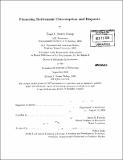Financing retirement consumption and bequests
Author(s)
Bishop, Tonja Bowen
DownloadFull printable version (14.28Mb)
Other Contributors
Massachusetts Institute of Technology. Dept. of Economics.
Advisor
James M. Poterba.
Terms of use
Metadata
Show full item recordAbstract
This dissertation consists of three essays that evaluate possible vehicles for financing either retirement consumption or bequests. Chapter 1 compares the use of Roth and tax-deferred retirement accounts for retirement consumption with the use of taxable accounts. Previously, economists have often assumed that retirement savings should be done in a tax-deferred account. However, the advent of Roth-style tax-favored accounts and concerns about the tax implications of increasing retirement income through distributions from tax-deferred accounts warrant revisiting this question. I use data on married couples in the HRS and NBER's TAXSIM model to measure the probability of a household facing a higher tax rate at ages 62, 65, and 69 than the household faced at age 57. When the marginal tax rate is higher, the household could decrease their lifetime tax burden by choosing a Roth-style account over a tax-deferred account. I also measure the probability of facing a marginal tax rate that is sufficiently high that the household minimizes tax payments by using a taxable account rather than a tax-deferred account, when a Roth option is not available. I find that for distributions beginning at age 69, between 10 and 35% of households with taxable income at age 57 should prefer a Roth account to a tax-deferred account, but very few households prefer a taxable account. Chapter 2 models the tax-savings available through the use of tax-favored retirement accounts for bequests. Past research on tax-favored retirement accounts has focused on the incentives and effects of these accounts within the framework of the life-cycle model. (cont.) However, tax-favored accounts also offer substantial tax savings for bequeathed assets. This chapter examines the incentives tax-favored accounts provide for bequests and simulates models of the available tax savings. The benchmark model calculates that the tax savings associated with a tax-deferred account (TDA) that is used to optimally bequeath assets exceeds the tax savings of a TDA used to produce a steady stream of retirement income by by 27.2%. Use of a Roth account for a bequest increases tax savings by an additional 32% over a bequeathed TDA. Chapter 3, joint work with Hui Shan, considers reverse mortgages as a method of financing retirement consumption. Housing wealth is the most important non-pension wealth component for many elderly homeowners in the United States. Reverse mortgages allow elderly homeowners to consume housing wealth without having to sell or move out of their homes. Though the U.S. reverse mortgage market has grown substantially, very few eligible homeowners use reverse mortgages to achieve consumption smoothing. This chapter examines all Home Equity Conversion Mortgage (HECM) loans originated between 1989 and 2007 and insured by the Federal Housing Administration (FHA). It shows how characteristics of HECM loans and HECM borrowers have evolved over time, compares borrowers with non-borrowers, and analyzes loan outcomes using a hazard model. (cont.) In addition, it conducts numerical simulations of HECM loans originated in 2007 to illustrate how the profitability of the FHA insurance program depends on factors such as termination rates, housing price appreciation, and the schedule of payments. This analysis serves as a starting point in understanding the implications of recent growth in the reverse mortgage market. Our results also suggest caution in predicting the profitability of the current HECM program.
Description
Thesis (Ph. D.)--Massachusetts Institute of Technology, Dept. of Economics, 2009. Cataloged from PDF version of thesis. Includes bibliographical references (p. 144-149).
Date issued
2009Department
Massachusetts Institute of Technology. Department of EconomicsPublisher
Massachusetts Institute of Technology
Keywords
Economics.